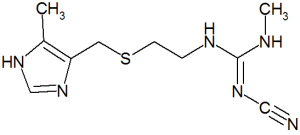Cimetidine
Cimetidine is a histamine H2-receptor antagonist that inhibits the production of acid in the stomach. It is largely used in the treatment of heartburn and peptic ulcers. It is marketed by GlaxoSmithKline under the trade name Tagamet®, and was approved by the Food & Drug Administration for prescriptions starting January 1, 1979. more...
Clinical Use
History and development
Cimetidine was the prototypical histamine H2-receptor antagonist from which the later members of the class were developed. Cimetidine was the culmination of a project at Smith, Kline & French (SK&F; now GlaxoSmithKline) to develop a histamine receptor antagonist to suppress stomach acid secretion.
At the time (1964) it was known that histamine was able to stimulate the secretion of stomach acid, but also that traditional antihistamines had no effect on acid production. In the process, the SK&F scientists also proved the existence of histamine H2-receptors.
The SK&F team used a rational drug-design structure starting from the structure of histamine - the only design lead, since nothing was known of the then hypothetical H2-receptor. Hundreds of modified compounds were synthesised in an effort to develop a model of the receptor. The first breakthrough was Nα-guanylhistamine, a partial H2-receptor antagonist. From this lead the receptor model was further refined and eventually led to the development of burimamide - the first H2-receptor antagonist. Burimamide, a specific competitive antagonist at the H2-receptor 100-times more potent than Nα-guanylhistamine, proved the existence of the H2-receptor.
Burimamide was still insufficiently potent for oral administration and further modification of the structure, based on modifying the pKa of the compound, lead to the development of metiamide. Metiamide was an effective agent, however it was associated with unacceptable nephrotoxicity and agranulocytosis. It was proposed that the toxicity arose from the thiourea group, and similar guanidine-analogues were investigated until the ultimate discovery of cimetidine.
Shortcomings
Cimetidine is a known inhibitor of many isozymes of the cytochrome P450 enzyme system (specifically CYP1A2, CYP2C9, CYP2C19, CYP2D6, CYP2E1, and CYP3A4). This inhibition forms the basis of the numerous drug interactions that occur between cimetidine and other drugs. For example, cimetidine may decrease metabolism of some drugs, such as oral contraceptives.
Adverse drug reactions were also found to be relatively common with cimetidine.
The development of longer-acting H2-receptor antagonists with reduced adverse effects such as ranitidine proved to be the downfall of cimetidine and, whilst it is still used, it is no longer amongst the more widely used H2-receptor antagonists.
Read more at Wikipedia.org



